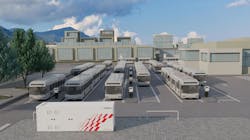Scaling charging infrastructure: Planning for the future of your electric fleet
Every pathway to a carbon-neutral future has one common denominator: increased electrification. One of the major catalysts for achieving this carbon-neutral future is modernizing the transportation sector to be more sustainable and efficient, which ultimately means more electric. What do transportation companies need to do to make this future a reality? Is our energy infrastructure ready to support the massive growth in electrification, which in the U.S. could be as much as 80% from 2018 to 2050, according to the National Renewable Energy Laboratory? This growth is expected to be driven largely by transportation electrification.
As they move toward a more sustainable future, transportation organizations are considering how best to integrate electric vehicles (EVs) into their current fleets. This presents a variety of challenges, such as: how to operate EVs and internal combustion vehicles side by side; how to blend EVs into their operational systems and processes; how to prepare grids for the widespread introduction of EV charging infrastructure; how to incorporate charging equipment into space-constrained environments; and how to effectively manage the potential associated spikes in demand and the increased consumption of electricity.
In short, electrification is a complex, complicated, and far-reaching process that will require a strategic, holistic approach where fleet owners are charging more with less, specifically during off-peak pricing periods, if it is to be successful.
Challenges of preparing grid infrastructure for increased electrification
Establishing a connection to the grid is an essential piece of the electrification puzzle, and this will require time and planning from utilities, fleet owners, and solution providers. Why? Uptime is paramount for many commercial fleets; keeping vehicles on the road is one of the most important drivers for their business. In many cases, as fleets shift toward more aggressive adoption of EVs, they will need charging infrastructure that can handle dynamic, fast-changing requirements throughout the day. Fleet owners need to take into account the timing of EV charging with an eye toward minimizing the contribution those charging requirements make to peak demand and keeping costs in check, a challenge which will become more critical as they scale their operations.
Among the challenges they will face is addressing needed infrastructure upgrades—both within the depot and in local grids—which will need to be pursued in partnership with utility partners. Businesses should also consider factors like the availability of public charging infrastructure when mapping driver routes, which could in some circumstances help offset their own infrastructure investments while maintaining uptime, particularly during the early stages of EV adoption.
Integrating EVs into fleets
In an electrified future, there are many variables for fleet owners to consider: investments in setting up chargers; aligning charging infrastructure with existing processes and systems for vehicle monitoring, maintenance, repair, and scheduling; and managing shifts in driver behavior, practices, and routes.
By building out holistic teams to focus on sustainability strategies, businesses will be able to effectively scale decarbonization efforts and implement appropriate management processes.
The strategic integration of EVs will include planning around:
- Defining the use cases for fleet vehicles and associated range requirements
- Energy requirements, EV charging infrastructure requirements, and grid integration requirements
- Dwell time expectations (where, when, and how long)
- Other electric energy usage for unrelated services at the charging depot or terminal
- Energy supply rates, tariffs, and demand charges
Fleet owners also must assess IT requirements, such as EV charging infrastructure control, site energy management and optimization, vehicle state-of-charge management, vehicle telematics system integration, vehicle scheduling system integration, and vehicle maintenance scheduling and optimization. Businesses are actively developing strategies to manage these challenges, but this process will take time.
Charging more with less
Fleet monitoring and management at-scale are impossible to do manually. To ensure successful implementation, fleet owners must be prepared to invest in charging infrastructure for large fleets, providing efficient operation in confined spaces.
Why is this important? The reality is that space is already a challenge for many operators of commercial fleets. In existing depots and logistics centers, real estate may already be very limited and needs to be carefully optimized. The use of parking spaces, maintenance bays, loading docks, and more must be synchronized to ensure smooth operations, and there is often little in the way of spare square footage available. In such cases, installing individual, stand-alone charging stations at each parking spot is both impractical and costly.
As an alternative, modular and customizable solutions for the large-scale EV charging of smart public and commercial transport, which are now commercially available, can optimize vehicle charging and offer a variety of benefits. For instance, the installation of centralized charging units, which can serve multiple of vehicles simultaneously, can dramatically reduce space requirements and cabling. These units offer more flexibility, since they can be installed outside of the building footprint, on rooftops, or elsewhere in the building rather than in the immediate parking area.
These systems also offer simplified interfaces, lower harmonic distortion, and improved reliability, availability, and maintainability. They also typically have simpler construction requirements, shorter delivery times, and lower risk of project delays—all of which can enable an easier transition to EV charging. Perhaps most important, such systems are designed to scale easily, enabling fleet operators to start with charging capabilities for just a few vehicles, but expand quickly and easily as they build out their EV fleet.
The use of analytical models and other tools can help guide the planning of effective, strategic scaling of electrification. Similarly, capabilities such as proactive diagnostics and guided repair can be integrated with charging systems to provide an overall solution for maintenance and service for expanding EV fleets.
Expanding that approach to encompass EV charging and applying digital monitoring capabilities across depots and fleets will enable operators to provide efficient charging operations in confined spaces, minimize grid impact, and make the best use of energy resources—ultimately reducing cost and carbon footprint. These and other technologies can enable commercial fleets to make the shift to electrification at scale.
Paving the way for increased electrification
Businesses are already taking important steps and making investments to prepare for the large-scale integration of EVs into their fleets. With the help of advanced charging solutions powered by digital platforms, fleet operators will be able to efficiently transition to electrified fleets that will help make their operations more sustainable and cost-efficient. However, efforts geared toward widespread electrification across our transportation infrastructure are really in their infancy. Commercial fleets are in an ideal position to drive progress in the EV industry and can benefit from significant cost and efficiency benefits along the way. A smart, considered approach to planning and deploying charging infrastructure tailored to their unique needs, will be an important step in that direction.
Anthony Allard is Executive Vice President, Managing Director, United States and Head of Hitachi Energy’s business in North America. Allard was most recently Chief Operating Officer of BECIS, a leading energy as a service solution provider in Singapore. Having spent most of his career in the power sector at GE and Alstom in the US, he held several executive-level positions, including General Manager and Board Member for GE Prolec Transformers in the US. He was also General Manager for the GE-XD High Voltage Products partnership and spent 10 years working for Alstom Grid in both North America and the Americas in Strategy and Operations management roles.
About the Author

Anthony Allard
EVP, Managing Director, United States | Head of Hitachi Energy North America
Anthony Allard is Executive Vice President, Managing Director, United States and Head of Hitachi Energy’s business in North America. Allard was most recently Chief Operating Officer of BECIS, a leading energy as a service solution provider in Singapore. Having spent most of his career in the power sector at GE and Alstom in the US, he held several executive-level positions, including General Manager and Board Member for GE Prolec Transformers in the US. He was also General Manager for the GE-XD High Voltage Products partnership and spent 10 years working for Alstom Grid in both North America and the Americas in Strategy and Operations management roles.
